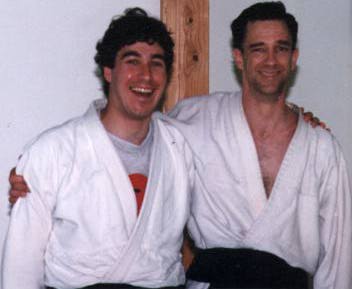 Changing
Dojos
Changing
Dojos Changing
Dojos
Changing
Dojosby Mark Binder
It's easier to change dojos as a black belt than as a kyu rank. And it still takes time.
In 1994, I moved from Rhode Island Aikikai to Northeast Aikikai in Chelmsford Massachusetts. I'd met Lou Perriello Sensei at several seminars, but hadn't really paid him much attention. In Providence, I was the senior student, teaching several days a week, and suddenly, I was just another Shodan in a dojo filled with Nidans and Sandans.
At first it was great. I was welcomed. I loved not teaching, avoided lower ranking students like the plague, and practiced only with black belts. What a luxury, to be able to learn from a fellow student's technique, rather than try and show him what was wrong.
Then I started noticing the differences. My old teacher, Glenn Webber, was a student of Chiba Sensei, and practiced with a vigorous unrelenting style that emphasized rapid attacks, and lightening ukemi. Lou was older than Glenn, moved differently and had bad knees. He rarely took ukemi, and the students &emdash; especially the higher ranking kyus &emdash; were (I thought) lazy about their attacks, and very nearly dangerous in their ukemi.
As a newcomer, I kept my peace… for a while.
Then came the first promotion testing, and I had a problem. Not with the techniques, but with the uncommitted attacks.
The Dan students were given an opportunity to critique the tests, so I spoke up. My heart pounded. In my mind, the equation was simple. Without a committed attack, there is no need for technique. Not only that, a lame attack made technique hard, forcing nage to initiate movement and energy, since uke wasn't giving him any.
When I was finished, I bowed, and for several more months went back to my own training. Now I brought a renewed effort. I would show them what I meant by vigorous attack.
Still nothing changed, except some people avoided practicing with me. I heard murmurs about some other's unhappiness with me. No one's attacks got better, and the third, second, and first kyus' ukemi continued to be precarious.
At last, in utter frustration, I announced that I would be holding a series of ukemi workshops on Sundays. After checking with Lou, I posted a sign-up sheet on the bulletin board. There were three students at the first session. Seven at the second. Four at the third. They were all beginners or low-ranking students. I was happy teaching beginners the value in learning ukemi, but I wasn't reaching the people who I thought needed it.
My enthusiasm waned. I began to slacken my own attacks. My ukemi grew sloppy. I started to get hurt.
Then another "transfer" student moved into the dojo. Chris Newport was a second kyu from Burlington, Vermont, who had studied with Terry Dobson. Chris's attacks and ukemi were superb, and I remembered the fun that I used to have in taking falls.
Using Chris, and another shodan, Mike Wood, as my examples, I began bringing my ukemi back up to speed. My teaching schedule picked up, but rather than being on a crusade, I was merely instructing. Blending with the current rather than fighting against it?
In the past few months I've had compliments from several of the kyu students who I had railed against. "You give good attacks," one said. During a shodan test, I saw another take a beautiful break fall.
At the same time, I've finally begun to absorb the many subtleties of Lou's teaching. When I first arrived, Northeast Aikikai's techniques seemed about 30 degrees off the line from what I'd learned. I'd struggled, and found myself frequently frustrated.
How foolish I'd been &emdash; senior student, just a shodan, from another dojo, coming in like a whirlwind to show the old-timers the "true" way.
Thankfully, one of Aikido's chief lessons is patience. If I'd pulled the same stunt in a Karate or Judo dojo, I'd probably have had both my arms broken.
Copyright 1996 by Mark Binder, All Rights Reserved